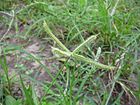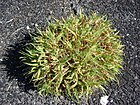Note: This is a project under development. The articles on this wiki are just being initiated and broadly incomplete. You can Help creating new pages.
Difference between revisions of "Dactyloctenium aegyptium"
| (2 intermediate revisions by the same user not shown) | |||
| Line 1: | Line 1: | ||
| − | + | [[File:Dactyloctenium aegyptium (2879481922).jpg|thumb|right]] | |
| − | + | '''Dactyloctenium aegyptium''' grass is a glaucous annual with culms up to 70cm high. The plant can form a mat with short underground stems. The seed is sometimes harvested from the wild for food, but generally only in times of scarcity. The plant also has local medicinal uses. | |
==Uses== | ==Uses== | ||
| − | {{Uses| | + | {{Uses|Dysentery}}. |
==Parts Used== | ==Parts Used== | ||
| − | {{Parts Used| | + | {{Parts Used|Seeds}}. |
==Chemical Composition== | ==Chemical Composition== | ||
| Line 30: | Line 30: | ||
==Habit== | ==Habit== | ||
| − | {{Habit|}} | + | {{Habit|Annual}} |
==Identification== | ==Identification== | ||
| Line 49: | Line 49: | ||
==Mode of Propagation== | ==Mode of Propagation== | ||
| − | {{Propagation|}} | + | {{Propagation|Seeds}} |
==How to plant/cultivate== | ==How to plant/cultivate== | ||
| − | <ref name="How to plant/cultivate"/> | + | A plant of dry to moist tropical and subtropical areas, where it is found at elevations from sea level to 2,000 metres.<ref name="How to plant/cultivate"/> |
==Commonly seen growing in areas== | ==Commonly seen growing in areas== | ||
| − | {{Commonly seen|}}, {{Commonly seen|}}, {{Commonly seen|}}, {{Commonly seen| | + | {{Commonly seen|Grassland}}, {{Commonly seen|Open woodland}}, {{Commonly seen|Common by roadsides}}, {{Commonly seen|On waste ground}}. |
==Photo Gallery== | ==Photo Gallery== | ||
<gallery class="left" caption="" widths="140px" heights="140px"> | <gallery class="left" caption="" widths="140px" heights="140px"> | ||
| − | + | Dactyloctenium aegyptium (2879481922).jpg | |
| + | File:Dactyloctenium aegyptium 0001.jpg | ||
| + | Egyptian Grass (Dactyloctenium aegyptium) (16796308304).jpg | ||
| + | Starr 080604-5998 Dactyloctenium aegyptium.jpg | ||
</gallery> | </gallery> | ||
| Line 65: | Line 68: | ||
<references> | <references> | ||
| − | <ref name="chemical composition">[" | + | <ref name="chemical composition">[Chemistry]</ref> |
| + | |||
| + | <ref name="Leaf">[Morphology]</ref> | ||
| − | <ref name=" | + | <ref name="How to plant/cultivate">[http://tropical.theferns.info/viewtropical.php?id=Dactyloctenium+aegyptium Cultivation]</ref> |
| − | |||
| − | |||
</references> | </references> | ||
==External Links== | ==External Links== | ||
| − | * [ ] | + | * [https://www.flowersofindia.net/catalog/slides/Crowfoot%20Grass.html Dactyloctenium aegyptium on flowersofindia.net] |
| − | * [ ] | + | * [https://indiabiodiversity.org/species/show/243314 Dactyloctenium aegyptium on indiabiodiversity.org] |
| − | + | ||
[[Category:Herbs]] | [[Category:Herbs]] | ||
[[Category:Pages without herbs images]] | [[Category:Pages without herbs images]] | ||
Latest revision as of 10:58, 23 April 2020
Dactyloctenium aegyptium grass is a glaucous annual with culms up to 70cm high. The plant can form a mat with short underground stems. The seed is sometimes harvested from the wild for food, but generally only in times of scarcity. The plant also has local medicinal uses.
Contents
- 1 Uses
- 2 Parts Used
- 3 Chemical Composition
- 4 Common names
- 5 Properties
- 6 Habit
- 7 Identification
- 8 List of Ayurvedic medicine in which the herb is used
- 9 Where to get the saplings
- 10 Mode of Propagation
- 11 How to plant/cultivate
- 12 Commonly seen growing in areas
- 13 Photo Gallery
- 14 References
- 15 External Links
Uses
Parts Used
Chemical Composition
Common names
| Language | Common name |
|---|---|
| Kannada | |
| Hindi | |
| Malayalam | |
| Tamil | |
| Telugu | |
| Marathi | |
| Gujarathi | |
| Punjabi | |
| Kashmiri | |
| Sanskrit | |
| English |
Properties
Reference: Dravya - Substance, Rasa - Taste, Guna - Qualities, Veerya - Potency, Vipaka - Post-digesion effect, Karma - Pharmacological activity, Prabhava - Therepeutics.
Dravya
Rasa
Guna
Veerya
Vipaka
Karma
Prabhava
Habit
Identification
Leaf
| Kind | Shape | Feature |
|---|---|---|
Flower
| Type | Size | Color and composition | Stamen | More information |
|---|---|---|---|---|
| {{{5}}} |
Fruit
| Type | Size | Mass | Appearance | Seeds | More information |
|---|---|---|---|---|---|
Other features
List of Ayurvedic medicine in which the herb is used
Where to get the saplings
Mode of Propagation
How to plant/cultivate
A plant of dry to moist tropical and subtropical areas, where it is found at elevations from sea level to 2,000 metres.[3]
Commonly seen growing in areas
Grassland, Open woodland, Common by roadsides, On waste ground.
Photo Gallery
References
- ↑ [Chemistry]
- ↑ [Morphology]
- ↑ Cultivation
External Links
- Ayurvedic Herbs known to be helpful to treat Dysentery
- Herbs with Seeds used in medicine
- Habit - Annual
- Index of Plants which can be propagated by Seeds
- Herbs that are commonly seen in the region of Grassland
- Herbs that are commonly seen in the region of Open woodland
- Herbs that are commonly seen in the region of Common by roadsides
- Herbs that are commonly seen in the region of On waste ground
- Herbs
- Pages without herbs images




